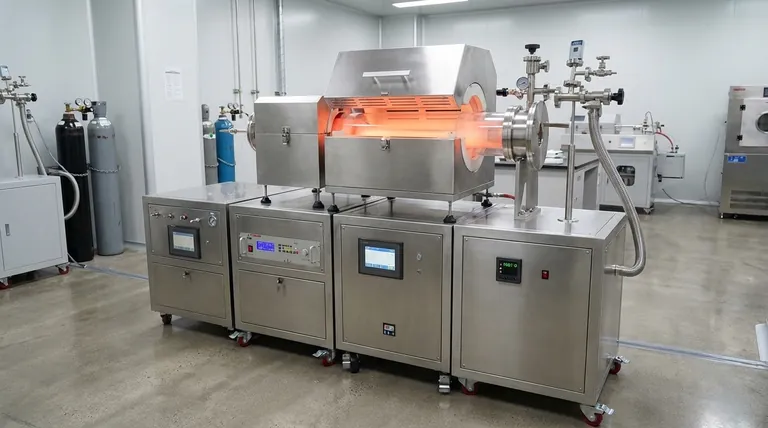While specific numbers vary greatly by material and process, Low-Pressure Chemical Vapor Deposition (LPCVD) is characterized by a relatively low deposition rate, often in the range of 10-100 nanometers per minute. This deliberate pace is not a flaw but a fundamental trade-off. LPCVD intentionally sacrifices speed to achieve the superior film quality, uniformity, and conformity required for demanding applications like semiconductor manufacturing.
The core takeaway is that LPCVD's value is not in its speed but in its precision. The low-pressure environment that slows down the deposition rate is the very same factor that enables the growth of exceptionally uniform and conformal thin films over complex surfaces.

Why LPCVD Is Engineered for Quality, Not Speed
Understanding the deposition rate of LPCVD requires looking at the principles that govern the process. The system's design choices—low pressure and high temperature—are made to optimize film properties, with the deposition rate being a secondary outcome.
The Role of Low Pressure
The low-pressure environment (typically 0.1 to 1.0 Torr) is the most critical factor. This vacuum condition dramatically increases the mean free path of the gas molecules.
This means reactant molecules can travel much farther without colliding with each other, allowing them to diffuse evenly throughout the reaction chamber and reach all wafer surfaces uniformly.
This enhanced gas diffusion is directly responsible for the excellent film thickness uniformity across a wafer and from wafer to wafer in a large batch.
The Impact of High Temperature
LPCVD operates at high temperatures, which provides the necessary thermal energy to drive chemical reactions directly on the heated wafer surface.
This is known as a surface-reaction-limited process. Because the reaction rate is controlled by the surface temperature (which is highly uniform) rather than by how fast gas can be supplied, the resulting film grows evenly on all exposed surfaces.
This characteristic gives LPCVD its signature high conformality, allowing it to perfectly coat the inside of deep trenches and complex 3D structures.
Eliminating Carrier Gases
Unlike other CVD processes that use inert carrier gases (like nitrogen or argon) to transport reactants, LPCVD does not. The low pressure alone is sufficient for gas transport.
This simplifies the process and, more importantly, reduces particle contamination. By removing carrier gases, a major source of potential impurities is eliminated, leading to higher-purity films.
Understanding the Trade-offs: Rate vs. Throughput
The decision to use LPCVD becomes clear when you evaluate its trade-offs. The process is a classic example of prioritizing precision over raw speed.
The Inherent Speed Limitation
The same low pressure that ensures uniformity also means there is a lower concentration of reactant molecules available in the chamber.
With fewer molecules impinging on the wafer surface per second, the film growth rate is naturally slower than in atmospheric pressure systems where reactant concentrations are thousands of times higher.
The Power of Batch Processing
While the deposition rate per wafer is low, LPCVD systems compensate by processing wafers in large batches. Wafers are typically stacked vertically in a tube furnace.
A single LPCVD run can process 100-200 wafers simultaneously. This high-volume batch capability improves the overall throughput, making the slow deposition rate economically viable for mass production.
When Quality is Non-Negotiable
For many critical layers in microfabrication—such as polysilicon gate electrodes or silicon nitride insulation layers—perfect uniformity and conformality are essential for device performance.
In these cases, a flawless film deposited slowly is infinitely more valuable than a thick, non-uniform film deposited quickly. The controlled, predictable nature of LPCVD is its primary advantage.
Making the Right Choice for Your Goal
Selecting a deposition technique depends entirely on your primary objective. The "best" method is the one that aligns with your specific film requirements.
- If your primary focus is exceptional uniformity, purity, and conformality for complex structures: LPCVD is an ideal choice, as its lower deposition rate is the direct trade-off for achieving these superior film properties.
- If your primary focus is high deposition speed for simpler, less sensitive layers: You may want to evaluate other methods like Atmospheric Pressure CVD (APCVD) or Plasma-Enhanced CVD (PECVD), which often offer higher rates at a lower temperature.
Ultimately, LPCVD is a process engineered for deliberate control, where every parameter is optimized to produce the highest quality film possible.
Summary Table:
| LPCVD Characteristic | Typical Range / Description |
|---|---|
| Deposition Rate | 10 - 100 nanometers per minute |
| Operating Pressure | 0.1 - 1.0 Torr |
| Process Type | Surface-reaction-limited |
| Key Advantage | Exceptional uniformity & conformality |
| Throughput Method | High-volume batch processing (100-200 wafers) |
Need a deposition process that prioritizes precision over speed?
KINTEK specializes in providing the lab equipment and consumables that enable controlled processes like LPCVD. Our expertise ensures you achieve the superior film quality, uniformity, and purity required for your most demanding applications, from semiconductor manufacturing to advanced materials research.
Contact our experts today to discuss how we can support your specific thin-film deposition needs.
Visual Guide

Related Products
- Chemical Vapor Deposition CVD Equipment System Chamber Slide PECVD Tube Furnace with Liquid Gasifier PECVD Machine
- RF PECVD System Radio Frequency Plasma-Enhanced Chemical Vapor Deposition RF PECVD
- Customer Made Versatile CVD Tube Furnace Chemical Vapor Deposition Chamber System Equipment
- Vacuum Hot Press Furnace Machine for Lamination and Heating
- 1200℃ Split Tube Furnace with Quartz Tube Laboratory Tubular Furnace
People Also Ask
- What are the examples of CVD method? Discover the Versatile Applications of Chemical Vapor Deposition
- What is the difference between CVD and PVD process? A Guide to Choosing the Right Coating Method
- What is the difference between CVD and PECVD? Choose the Right Thin-Film Deposition Method
- What is the precursor gas in PECVD? The Key to Low-Temperature Thin Film Deposition
- How is PECVD different from CVD? Unlock Low-Temperature Thin Film Deposition



















